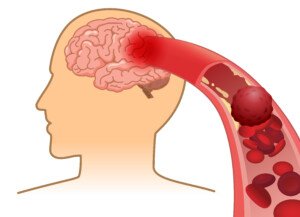
See a doctor ASAP if you have sudden but temporary blurred vision, as this can be a harbinger of an awful outcome.
There are many causes of blurry vision, but let’s get more specific:
Your vision suddenly — not gradually — becomes blurred, and this lasts only minutes, maybe even 30 seconds, and then everything is back to normal, as though nothing had happened.
This may deceive you into thinking nothing serious happened.
But most likely, something very sinister just did.
Sudden onset blurry vision that doesn’t last long can be caused by a transient blood clot in the brain.

A blood clot in the brain can cause sudden blurry vision. Shutterstock/solar22
Here is what Cindy P. Wang, O.D., F.A.A.O., with South Pasadena Optometric Group in CA.says about this:
“If the visual disturbances are similar to a slow dimming of vision or blacking out of vision, and it lasts for five to 10 minutes, then it is likely caused by a mini-stroke, also known as a transient ischemic attack (TIA).”
Though the visual problem, caused by a TIA, is sometimes described as dimming or fading out, it’s also possible for a TIA to specifically cause sudden blurred vision that’s only temporary (a TIA, by definition, is temporary).
It may last less than five minutes, too.
In fact, strokefoundation.com states that “sudden blurred or decreased vision in one or both eyes” is one possible symptom of a TIA.
Medical Emergency
If you experience a sudden onset of blurred vision, even in one eye, this is a medical emergency, “caused by, but not limited to, atherosclerosis, carotid artery stenosis, heart disease, hypertension and diabetes,” says Dr. Wang.
“In this case, you should see your primary care physician or neurologist as soon as possible, especially if accompanied by other symptoms such as headaches, scalp tenderness or fever, which may indicate an inflammatory cause of vision loss.”
Ideally, you should have someone drive you to the emergency room.
Immediate medical attention is extremely important, as TIAs are harbingers of future strokes.
Even if you ultimately are not diagnosed with a TIA, it’s always better to be safe than sorry.
About 30% of people who experience a TIA — regardless of the type of symptoms it caused — are at risk of having a stroke within the following 30 days.
These grim odds can be dramatically lessened if there is immediate intervention and hence, management of the disease process that led to the transient ischemic attack in the first place.
Below is the “FAST” guide for identifying a TIA or a stroke.
Never blow off a sudden experience of blurred vision, no matter how brief.
If you’ve had a transient ischemic attack, it means there’s likely a partially blocked artery leading to your brain or a clot source in the heart.
- Arm or leg weakness, particularly on one side
- Clumsiness or loss of balance
- One-sided numbness or tingling
- Facial drooping or numbness, particularly on one side
- Severe headache
- Cognitive change, confusion
- Speech difficulties or slurring
- Swallowing difficulty
- Visual disturbances such as blurriness or seeing double

 Dr. Wang
Dr. Wang







































